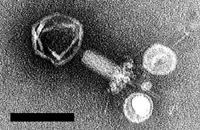
Despite a striking resemblance to an E. coli virus, this marine virus appears to have evolved genes adapted to infecting photosynthetic bacteria inhabiting low nutrient oceans. (Scale bar indicates 100 nm) (Image: Peter Weigele)Cyanobacteria exert a disproportionate influence on their planet for their size. The Prochlorococcus group of cyanobacteria account for a large fraction of global photosynthesis by virtue of their ubiquitous presence in nutrient-depleted ocean waters. Even tinier agents - the viruses that infect these bacteria, called cyanophages - appear capable of wielding surprising influence on global cycles by affecting the population dynamics and evolutionary path of Prochlorococcus. An investigation of the genetic makeup of three cyanophages in the freely-available online journal PLoS Biology helps reveal the complex role these phages might have on our great planetary cycles.
To understand the nature of virus–host interactions at sea, Sallie Chisholm and colleagues sequenced three marine phages - one podovirus and two myoviruses - based on their morphology and host range, and characterized their genomes. The marine phages resemble two terrestrial phages - called T4 and T7 - that infect Escherichia coli but also carry genes that appear specially adapted to infecting photosynthetic bacteria in nutrient-poor oceans. Some genes are likely derived from cyanobacteria that "could play defining functional roles" in marine phage–host interactions. All three cyanophages contain photosynthesis-related genes, some of which could mean that the virus helps the host maintain photosynthesis during infection. The podovirus also has a candidate gene involved in DNA synthesis, which the authors speculate could allow the virus to reproduce in nutrient-poor environments, and all three cyanophages carry genes involved in metabolizing carbon. The absence of such genes in terrestrial phages, the authors argue, lends support to the notion that marine phages have evolved different adaptive mechanisms in response to the ocean environment.
Given the intimate relation between virus and host, the effects of gene swapping between virus and host is likely to be a two-way street. Just as cyanophages may help shape the fate of their hosts, it's likely that cyanobacterial genes influence phage ecology and perhaps even its range. The cyanophages characterized here take after two phages that were central to many fundamental breakthroughs in molecular biology, including the discovery that genes are made of DNA. It remains to be seen how the marine versions of these legendary laboratory viruses contribute to our understanding of phage infections in one of the most abundant, ecologically diverse primary producers in the open seas. See also the related Primer "The Third Age of Phage" in the May issue of PLoS Biology (DOI: 10.1371/journal.pbio.0030182).
###
Citation: Sullivan MB, Coleman ML, Weigele P, Rohwer F, Chisholm SW (2005) Three Prochlorococcus cyanophage genomes: Signature features and ecological interpretations. PLoS Biol 3(5): e144.
Source (Image and text) : PLoS Biology
 Print Article
Print Article Mail to a Friend
Mail to a Friend
